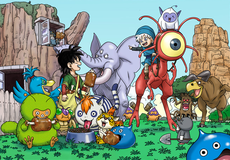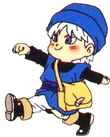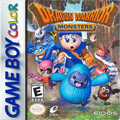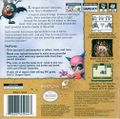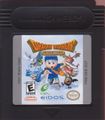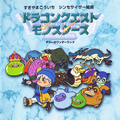Dragon Quest Monsters: Difference between revisions
No edit summary |
No edit summary |
||
| (15 intermediate revisions by 4 users not shown) | |||
| Line 2: | Line 2: | ||
|type=Spinoff games | |type=Spinoff games | ||
|title=Dragon Quest Monsters | |title=Dragon Quest Monsters | ||
|image=[[Image:DWM_Logo.png|340px]][[File:DQM | |image=[[Image:DWM_Logo.png|340px]][[File:DQM 1 page header image.png|350px]] | ||
|developer=[[TOSE]] | |developer=[[TOSE]] | ||
|publisher={{vgrelease|JP=[[Enix]]}}{{vgrelease|NA=Enix/[[Eidos Interactive]]}} | |publisher={{vgrelease|JP=[[Enix]]}}{{vgrelease|NA=Enix/[[Wikipedia:Square Enix Europe|Eidos Interactive]]}} | ||
|designer=[[Yuji Horii]] | |designer=[[Yuji Horii]] | ||
|series = | |series = {{Monsters Series}} | ||
|engine= | |engine= | ||
|released={{vgrelease|JP=September 25, 1998}}{{vgrelease| | |released= '''Game Boy Color''' <br />{{vgrelease|JP=September 25, 1998|NA=January 25, 2000|EU=January 28,2000}}'''Cell phone''' <br />{{vgrelease|JP=January 28, 2000}}'''Nintendo Switch''' <br /> {{vgrelease|JP=September 17, 2019}}'''iOS / Android''' <br />{{vgrelease|JP=November 6, 2019}} | ||
|genre=[[Wikipedia:Console role-playing game|Console role-playing game]] | |genre=[[Wikipedia:Console role-playing game|Console role-playing game]] | ||
|modes=[[Wikipedia:Single-player|Single-player]], [[Wikipedia:multiplayer game|multiplayer]] | |modes=[[Wikipedia:Single-player|Single-player]], [[Wikipedia:multiplayer game|multiplayer]] | ||
|ratings={{vgratings|ESRB=E (Everyone)|ELSPA=3+}} | |ratings={{vgratings|ESRB=E (Everyone)|ELSPA=3+}} | ||
|platforms= | |platforms={{Game Boy Color}}<br>[[Cell phone]]s (Japan)<br>[[Nintendo Switch]] (Japan) | ||
|media=16 megabit [[Game Boy]] Color [[Wikipedia:Cartridge (electronics)|cartridge]], backwards compatible with [[Game Boy]] | |media=16 megabit [[Game Boy]] Color [[Wikipedia:Cartridge (electronics)|cartridge]], backwards compatible with [[Game Boy]] | ||
|requirements= | |requirements= | ||
|input= | |input= | ||
}} | }} | ||
'''Dragon Quest Monsters''' (titled ''' | '''Dragon Quest Monsters''' (titled Dragon '''Warrior''' Monsters for the US release) is the first game in the ''Dragon Quest'' spin-off series, {{Monsters Series}}. Released for the Nintendo [[Game Boy]] Color in 1998, it stars a young [[Terry]] from {{Dragon Quest VI}} as the [[Hero]] as he journeys to the fantastical kingdom of [[GreatTree]] to rescue his sister [[Milly]]. | ||
Whereas | Whereas the main series focuses on the adventures of a hero rising up against the forces of darkness, ''DQM'' revolves around what it means to be a [[Monster Master]] and is the much smaller-scale story of two little siblings, Terry and Milly, when they were just small children. The game opens with Milly's kidnapping by a naughty creature called [[Scruffy]], after which a polite monster called [[Fluffy]] appears and explains the situation to the shocked lad, spiriting Terry off to GreatTree and starting his quest to rescue his sister. | ||
==Story== | ==Story== | ||
The game begins with young [[Terry]] and [[Milly]] living peacefully in their house, in the days before | The game begins with young [[Terry]] and [[Milly]] living peacefully in their house, in the days before {{Dragon Quest VI}}, when Terry and Milly were just children. When they go to bed at night, Terry gets up and goes into the next room. A strange monster then appears from a dresser kidnaps Milly and then vanishes back into the dresser he came from. Soon after, another monster, similar to the kidnapper, appears from the same dresser looking for Milly, but is surprised to learn that she has already been taken away. The monster, Fluffy, then asks Terry if he would like to find out where his sister and the kidnapper are, and to follow him to the Kingdom of GreatTree. Fluffy and Terry both go into the dresser and Terry then finds himself in a tree so large an entire thriving kingdom is set within its branches. Terry speaks with the king and explains his situation, with the king suggesting that the best way to find his sister is to win the monster master's [[Starry Night Tournament]], as he will be granted a wish. Terry is then given a [[Slime]] named Slib to help him along, and the two set out to explore the many worlds connected to GreatTree to win the tournament and rescue his sister. | ||
==Gameplay== | ==Gameplay== | ||
''DQM'' took the [[Monster recruitment|monster-taming]] elements of {{Dragon Quest V}} and expanded upon them, also borrowing a few mechanics from the ''[[Pokémon]]'' series and addressing the criticisms of that franchise, setting the standards for what would become the "''Dragon Quest Monsters'' series." The basic concept is that Terry, as a young boy still too weak to fight for himself, must enlist the help of various creatures to act in his stead after being given a slime as a beginner monster. In order to win new monsters over to his side, Terry can lob [[Monster munchies|cuts of meat]] at a foe during battle, which will raise the base chance for a monster to join significantly. Each monster will learn three abilities, possess it's own innate resistances to the elements and status ailments, and have a fixed level cap. | |||
===Breeding=== | ===Breeding=== | ||
After beating Class F in the | After beating Class F in the tournament, the player [[Monster breeding|can breed monsters if they are at level 10]] or above at the Shrine of Starry Night, which is taken care of by the current Master Monster Tamer. Breeding requires one male and one female monster and the result of the breeding will be an egg containing a Level 1 monster which has characteristics of both parents, including skills and stats. The egg can then be left in the monster farm or hatched on the spot, which costs a small fee. The newly born monster will have a '''plus''' number next to it's name, the number representing the improvement over it's stats over those of it's parents, the higher being the better. It costs more money to hatch a monster with a higher plus number. Also, the number beside the plus multiplied by two is added to the limit for the maximum level for the monster. | ||
The ability to breed monsters is a direct answer to the criticisms of the ''[[Pokémon]]'' series, as it allows any species of monster to become a top-tier power house instead of being stuck with the limits assigned to it. Level and stat restrictions can be raised to any degree, strong resistances to all elements can be obtained, and up to eight abilities can be assigned to any type of monster with enough patience on the player's part, to the point that even a [[Burr baby]] can single-handedly tackle the final battle in the tournament by itself. | |||
=== | ===Egg evaluation=== | ||
Once the Egg Evaluator is available for use, eggs can have the gender of the monster they're containing checked and changed. Both | Once the Egg Evaluator is available for use, eggs can have the gender of the monster they're containing checked and changed. Both services require a small fee to the young woman, with the fee increases depending on the monster's plus number. | ||
===Monster | ===Monster farm=== | ||
[[File:DQM 3DS Feeding Time.png|right|thumb|230px|Pulio and the Monster Farm]] | [[File:DQM 3DS Feeding Time.png|right|thumb|230px|Pulio and the Monster Farm]] | ||
A storage place for | A storage place for monsters not in the active party, managed by a little boy named Pulio, where they can be picked up or dropped off. There is an option to put monsters at the farm to sleep, which allows them to maintain their wilderness level and allows the player to keep an additional 19 monsters but they will not gain experience or grow in level unlike non-sleeping monsters who do. There can be 19 awake and 19 asleep monsters at any one time. | ||
===Teleportals=== | ===Teleportals=== | ||
As the kingdom of GreatTree is rather small, Terry must venture out via the castle [[List of teleportals in Dragon Quest Monsters|teleportals]] and explore other worlds to recruit monsters. These warp vortexes are called ''travelers' gates'' in the game itself, as was the standard [[Dragon Quest localization history|Enix of America localization policy]] at the time. These gates lead to randomly-generated worlds based around set themes with a fixed variety of monsters assigned, and are located underneath the throne room. To access the portals, the player needs to defeat a class ranking in the starry night tournament. There are a certain number of areas in a given world, and at the last one the player needs to defeat a boss. Other gates are hidden throughout Great Tree, such as one in the library that is only accessible after befriending over 100 different monsters. | |||
Players of other games in the ''Dragon Quest'' series will recognize many of the bosses and and their lairs as homages to the main series. Examples include the [[Golem]] guarding the town of [[Cantlin]] and the [[Green dragon|Dragon]] holding [[Princess Gwaelin]] captive in the [[Quagmire Cave]] (both from the original {{Dragon Quest}}). Some bosses in the game offer to join the player's party automatically, some have to be won over with meat, and some will not join at all. | |||
Players of other games in the ''Dragon Quest'' series will recognize many of the bosses and | |||
=== | ===Monster arena=== | ||
[[File:DQM Watabou.png|right|border|120px]] | [[File:DQM Watabou.png|right|border|120px]] | ||
The monster arena is how the representative of the kingdom is selected for the starry night tournament. There are eight ranks that consists of three different battles that must be won before the player can advance to the next ranking. Each rank provides harder challenges: the higher the rank, the harder the battle. The player is able to select ranks G through D in the beginning, and these battles open up teleportals to explore and are necessary to progress through the story. | |||
The arena battles cost [[gold]] to enter: | The arena battles cost [[gold]] to enter: | ||
*'''Rank G:''' No fee | |||
*'''Rank F:''' 10G | |||
*'''Rank E:''' 50G | |||
*'''Rank D:''' 100G | |||
*'''Rank C:''' 500G | |||
*'''Rank B:''' 1000G | |||
*'''Rank A:''' 5000G | |||
*'''Rank S:''' 10000G | |||
*'''Starry Night Tournament:''' No fee | |||
===Mini medals=== | |||
These [[Mini medals|medals]] are scattered throughout different worlds and are randomly picked up. In the game, thee king of GreatTree pulls double duty as the requisite medal king, located east of the Monster Arena, and will give the following eggs for the cumulative number of mini medals brought to him in the original Game Boy game: | |||
*'''13 Medals:''' ''[[Thunderbird]]'' | |||
*'''18 Medals:''' ''[[Eyevory tusk-tusk]]'' | |||
*'''25 Medals:''' ''[[Tortoceratops]]'' | |||
*'''30 Medals:''' ''[[Liquid metal slime]]'' | |||
=== | |||
These medals are scattered throughout different worlds and are randomly picked up. In the game, | |||
'''13 Medals:''' ''[[Thunderbird]]'' | |||
'''18 Medals:''' ''[[ | |||
'''25 Medals:''' ''[[Tortoceratops]]'' | |||
'''30 Medals:''' ''[[Liquid metal slime]]'' | |||
===Foreign Masters=== | ===Foreign Masters=== | ||
[[File:DQMTerry.png|right|border|110px]] | [[File:DQMTerry.png|right|border|110px]] | ||
While in other worlds, the player can encounter other masters that they can battle with, if the player wins the master will do something for the player, if the player loses the master will take some items and hand the player a Warpwing. | While in other worlds, the player can encounter other masters that they can battle with, if the player wins the master will do something for the player, if the player loses the master will take some items and hand the player a Warpwing. The monsters that the foreign masters have with them change depending on the total level of the player's party. There are different types that will give or do different things for the player if they beat them: | ||
*'''Priest''' - Will heal the player's monster's HP and MP completely, as well as reviving any dead monsters. | |||
*'''Troubadour''' - Will give the player's party medicine that affects each of the monsters currently in the player's party, it raises 1 random stat by 20 points permanently. | |||
*'''Merchant''' - Will fill the player's inventory completely with random meats (Including BadMeat and Sirloins). | |||
*'''Male Warrior''' - Will give the player a Chimaera wing and a random item. | |||
*'''Female Warrior''' - The same as the male warrior. | |||
*'''Mage''' - Will teleport the player to either the very last floor in the dungeon or 20 floors down, whichever comes first. | |||
==Development== | |||
The concept of a monster-raising game had entered Yuji Horii's mind after the completion of ''Dragon Quest VI'', which featured an improved version of the monster arenas that had been a series staple since the third game. This iteration for the sixth game was called [[Slimopolis]], which allowed the player the enter their own monsters into the arena to win fantastic prizes instead of betting on randomly selected individuals. | |||
''' | Concurrently, there was a tremendous boom in horse-racing popularity in Japan during the mid-90's<ref>犬塚太一(以下、犬塚): それと同じくらいの時期に、世の中が競馬ブーム(※1)だったんですよ。打ち合わせをしても、みんな競馬の話ばかりしていて。『ベスト競馬ダービースタリオン(※2)』なんかも流行っていて。ドラゴンクエストモンスターズ 20thアニバーサリー モンスターマスターメモリーズ ISBN-13 :978-4757559356</ref>. Horii himself had caught the gambling bug during this time and enjoyed quite a bit of luck early on, winning ¥700,000 on a ¥1,000 ticket for the Queen Elizabeth II cup. He would continue gambling and ended up quitting horse racing after spending more than the ¥700,000 on bum tickets, but the fascination of watching horse races remained <ref>堀井: わりとすぐでしたね。いろいろな組み合わせを買っていたんですけど、そのうちの1枚が当たって。1000円が70万円くらいになったのかな。味をしめて、ノートに記録をつけて、「これからどんどん当てていこう」なんて思ったんですけど、それっきり。けっきょく、万馬券で当たった70万円よりもっと使っちゃって、競馬もやめちゃった(笑)。ドラゴンクエストモンスターズ 20thアニバーサリー モンスターマスターメモリーズ ISBN-13 :978-4757559356</ref>. During this time, series producer [[Yukinobu Chida]] contacted [[Taichi Inuzuka]] and asked him to develop a prototype of a game that featured similar elements to horse breeding, inspired by the [https://en.wikipedia.org/wiki/Derby_Stallion Derby Stallion game series] and his own experiences as a horse owner. The principal concepts were "making friends with monsters" and "alchemical synthesis" <ref>犬塚: 堀井さんも含めてそんな競馬ブームだったころに、千田さん(千田幸信/※4)から「配合の要素があるゲームを作れないだろうか」って話がありまして。「モンスターを仲間にする」というのと、「配合」。このふたつをセットにしてゲームにできないか、となったわけなんです。ドラゴンクエストモンスターズ 20thアニバーサリー モンスターマスターメモリーズ ISBN-13 :978-4757559356</ref>. When developing the story for the title, Horii felt that the precedent set by [[Torneko no Daibōken: Fushigi no Dungeon]] made it acceptable to use characters from mainline games in spinoffs and selected Terry as the protagonist for his strong reception among fans and ''Dragon Quest VI'' being the most recent game. Horii also asserted that using a familiar character would help players adapt more quickly to a brand new type of ''Dragon Quest'' experience<ref>堀井: 当時は『DQVI』が出たばかりのころで、スピンオフ作品としては『トルネコの大冒険不思議のダンジョン(※5)』がすでに発売されていたんです。だからモンスターを仲間にするゲームのほうは「主人公をテリーにして、ミレーユとの幼少期の話にすればいいんじゃない?」という感じで、まずは大まかなストーリーを決めていって。 | ||
犬塚: 本当の初期の構想段階では、主人公をテリーにするつもりはなかったんです。でも、堀井さんが「テリーにしよう」と言ってくださって。 | |||
堀井: やっぱり、親しみのあるキャラクターが主人公のほうがいいかな、って。そのほうが、ゲームに入りやすいからね。ドラゴンクエストモンスターズ 20thアニバーサリー モンスターマスターメモリーズ ISBN-13 :978-4757559356</ref>. | |||
'' | The reason for Terry and his sister Milly appearing as little children compared to their young adult selves from ''Dragon Quest VI'' was to emphasis that the game would exclusively feature monster-on-monster combat, with the player only serving as the guide in battle and not a direct participant<ref>堀井: テリーの幼少期の話にしようと思ったのは、モンスターだけを戦わせるようにしたかったからなんですよ。子どものテリーなら、戦闘に参加しなくてもおかしくないからね。ドラゴンクエストモンスターズ 20thアニバーサリー モンスターマスターメモリーズ ISBN-13 :978-4757559356</ref>. As the focus of the game was to raise monsters and make them stronger, Inuzuka proposed that the story should written to be more direct than a mainline title and guide the player through the functions of the game<ref>犬塚: 「いろいろなモンスターを強くしていこう」というのがテーマで、そのガイドとして物語があるような感じにしていきたかったんです。当初は「もっとハードな物語にしようか」なんて意見もあったりはしたんですけど。ドラゴンクエストモンスターズ 20thアニバーサリー モンスターマスターメモリーズ ISBN-13 :978-4757559356</ref>. Horii agreed with this notion and wrote the dialogue accordingly , best emphasized in the laid-back King of Greatlog telling Terry that if he wins the Starry Night Tournament then he will find his missing sister with no further elaboration<ref>堀井: でも、最終的にはみんながわかりやすいほうがいいかな,って。だから物語もけっこうシンプルなんですよ。王様が自分の都合で「星降りの大会で優勝したらミレーユが見つかるかも」なんて言い出したりして。ドラゴンクエストモンスターズ 20thアニバーサリー モンスターマスターメモリーズ ISBN-13 :978-4757559356</ref>. | ||
While the scenario of the game was deliberately made to be simple, considerable effort was placed on making the monster breeding system as intricate and rich as possible. The first grouping of combinations were rather plain, focusing only on inter-family recipes without much excitement; Horii would deem this unsatisfactory and wrote several new recipes himself<ref>堀井: やっぱり配合する楽しさだと思いますよ。その配合も、当初はかなりシステマチックで。 最初は、系統の掛け合わせだけしかなかったので、「これじゃつまらないよ」って言って、特殊配合をけっこう足した記憶があります。 | |||
犬塚: かなり足されましたね。堀井さんに「グレイトドラゴンとキングスライムで ドラゴスライムになるのはだめでしょ」って言われて、「確かになぁ」と。ドラゴンクエストモンスターズ 20thアニバーサリー モンスターマスターメモリーズ ISBN-13 :978-4757559356</ref>. There was also a conscious effort to avoid the bottlenecking phenomenon common in monster taming games, where in balance is poor and players gravitate towards using only a handful of monsters instead of picking their favorites. The "+" system was developed to counter this bad habit, insuring that any monster species can be turned into a powerhouse <ref>堀井: そこは、配合をするたびにプラスの数値が増えていって、強くなった証になればいいな、って思っていました。 ドラゴンクエストモンスターズ 20thアニバーサリー モンスターマスターメモリーズ ISBN-13 :978-4757559356</ref>. This system had the added bonus of making the multiplayer scene more competitive with an astronomical number of party configurations being perfectly viable. As it turns out, multiplayer battles were actually an afterthought added in simply because Horii thought they would be fun <ref>堀井: 『DQ』の世界っていうのは、基本的に人間どうしが戦わない世界なんです。でも、モンスターどうしを戦わせるということであれば、ちょっと挑戦ではあるけど、おもしろそうなのでいいかなって。それで、対戦の要素を入れました。そういう意味では、バトエン(※7)なんかも対戦って言えば対戦だし(笑)。ドラゴンクエストモンスターズ 20thアニバーサリー モンスターマスターメモリーズ ISBN-13 :978-4757559356</ref>. | |||
''' | The Nintendo [[GameBoy]] was decided to be the hardware the game would be released for, at Yukinobo Chida's insistance. He would reveal in the November 1997 issue of [https://en.wikipedia.org/wiki/Famitsu Famitsu magazine] that the children who played the original ''Dragon Quest'' had already grown into young adults by the time ''Monsters'' planning stage commenced and that the series would need to adapt to the changing audience of gamers. Simultaneously the release of [https://en.wikipedia.org/wiki/Pok%C3%A9mon_Red,_Blue,_and_Yellow Pokemon] in 1996 had created an explosive resurgence in the GameBoy's popularity amongst elementary students, leading to Chida to insist on developing ''Dragon Quest'' for the portable in an effort to establish the series with the so-called "GameBoy Generation". This is likely the reason why the boss fights are based on events from previous mainline games, such as Terry encountering [[Lizzie]] in a simplified version of [[Wayfarer's Pass]], as a way to get inexperienced kids interested in the series. In addition to ''Monsters'', the [[SNES]] compilation of [[Dragon Quest I & II]] was ported to the device to introduce the new generation to the foundation of RPGs. | ||
''' | |||
''' | |||
==Remakes and re-releases== | ==Remakes and re-releases== | ||
The game and its sequel | The game and its sequel {{DQM2}} were remade and released as ''Dragon Quest Monsters 1 + 2'' for the [[Sony PlayStation]]. However, it was only released in Japan and an unofficial translation surfaced, but was never completed/released. | ||
The game has also been remade for the 3DS in Japan as ''[[Dragon Quest Monsters: Terry's Wonderland 3D]]''. At this time, it is not likely to be released elsewhere in the world. | The game has also been remade for the [[Nintendo 3DS]] in Japan as ''[[Dragon Quest Monsters: Terry's Wonderland 3D]]''. In 2018 this remake was ported to smartphones in Japan, under the title "Dragon Quest Monsters: Terry's Wonderland SP". At this time, it is not likely to be released elsewhere in the world. | ||
On September 13th, 2019 a surprise announcement was made through Square-Enix's social media accounts, revealing the game will be ported to the Nintendo Switch on September 17th. This new port has been dubbed ''Dragon Quest Monsters: Terry's Wonderland ' | On September 13th, 2019, a surprise announcement was made through Square-Enix's social media accounts, revealing the game will be ported to the Nintendo Switch on September 17th. This new port has been dubbed ''[[Dragon Quest Monsters: Terry's Wonderland RETRO|Dragon Quest Monsters: Terry's Wonderland RETRO]]'', and includes the ability to switch between monochrome and colored graphics, a variety of display boarders reminiscent of the Super Game Boy that also display the stats of Terry's monsters in addition to just the current {{HP}} and {{MP}}, and an auto-mapping feature that can be toggled on or off. The game is digital only, and costs just 1,500 yen. The '''RETRO''' release was eventually ported to iOS and Android devices later that year as well, on November 6th, 2019, selling for 1,480 yen. It included the same features as the Switch release, along with making the controls and UI look like a Game Boy. | ||
==Sequel== | ==Sequel== | ||
A manga follow-up titled [[Dragon Quest Monsters+]] continues the tale of Great-Tree roughly one year after the events of the game. While the protagonist, Kleo, is an original addition to the setting, several veteran characters and monsters return. | A manga follow-up titled ''[[Dragon Quest Monsters +]]'' continues the tale of Great-Tree roughly one year after the events of the game. While the protagonist, Kleo, is an original addition to the setting, several veteran characters and monsters return. | ||
==Trivia== | |||
*''Dragon Quest Monsters'' is the first Game Boy Color title ever developed, and was released approximately one month prior to the technicolor hardware itself. As with all black cartridge gbc games, ''DQM'' is fully compatible with the original Game Boy, the Super Game Boy, and the Game Boy Pocket. | |||
*This game is the first in the series history where the details of final bosses have been included in official guide books. This information was included because Horii believed that it would give the game a festival-like feel, and that bosses should be included to begin with as there would be no reason why they shouldn't be in a monster-centric game in the first place<ref>堀井: お祭りみたいなゲームだからいいかなって。それに、強いものどうしの配合で、もっと強いモンスターにするゲームなんだから、やっぱりボスも出すしかないでしょ(笑)。ドラゴンクエストモンスターズ 20thアニバーサリー モンスターマスターメモリーズ ISBN-13 :978-4757559356</ref>. | |||
==Gallery== | ==Gallery== | ||
<center><gallery> | <center><gallery> | ||
DQM japanese box.jpg|Japanese box. | |||
File:DQM title card.png|Title card. | |||
DWM_Box (Front Side).png|American box. | |||
DWM_Box (Back Side).jpg| | |||
DQM japanese cart.jpg|Japanese cartridge. | |||
DWM Cartridge.jpg|American cartridge. | |||
DQM guide.png|Guide book. | |||
DQM_OST.png|Synthesizer Suite. | |||
DQM Manga.png|Manga. | |||
Dragon Quest Monsters I and II boxart.jpg|''Dragon Quest Monsters 1 + 2'' | |||
DQM1 and 2 guide.png|''DQM 1 + 2'' V Jump guide. | |||
DQM 1 and 2 cover art.png|''DQM 1 + 2'' boarderless artwork. | |||
DQM Terry.png|Terry. | |||
DQM 1 and 2 King.png|The King. | |||
DQM 1 and 2 Pulio.png|Pulio. | |||
DQM1 and 2 Mamon.png|Mamon the monster-hatcher. | |||
DQM GreatTree.png|The map of Great Tree. | |||
Dragon Quest Monsters super gameboy borders.png|The borders seen when played on the [https://www.mariowiki.com/Super_GameBoy Super Game Boy]. | |||
DQM retro announcement flyer.jpg|Announcement for the Switch release. | |||
DQM retro automap flyer.jpg|The auto-mapping feature. | |||
DQM retro detailed stats flyer.jpg|Stats display. | |||
Dqm retro flyer 2.jpg|Screenshot collage. | |||
DQMR App icon.png|Icon for the smartphone version. | |||
DQM Retro Smartphone 1.png|The Game Boy-styled controls and user interface for the smartphone version. | |||
DQM Retro Smartphone 2.jpg|Different interfaces for the smartphone version. | |||
</gallery></center> | </gallery></center> | ||
==External Link== | |||
*[http://dqm3d.ffsky.cn/monsters.htm ''List of monsters'' in remake] (Japanese) | |||
==References== | ==References== | ||
<references/> | |||
{{ | {{DQMI}} | ||
{{ | {{Dragon Quest series}} | ||
[[Category:Monsters series]] | [[Category:Monsters series]] | ||
[[Category:Dragon Quest Monsters]] | [[Category:Dragon Quest Monsters]] | ||
Latest revision as of 11:21, 24 March 2024
| Spinoff games | |
|---|---|
| Dragon Quest Monsters | |
 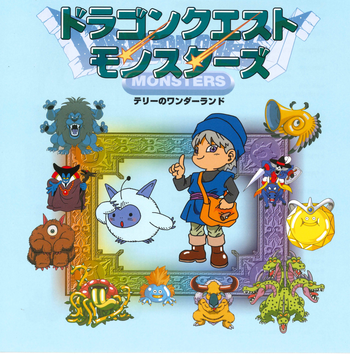
| |
| Developer(s) | TOSE |
| Publisher(s) | JP Enix NA Enix/Eidos Interactive |
| Designer(s) | Yuji Horii |
| Series | Dragon Quest Monsters |
| Platform(s) | Game Boy Color Cell phones (Japan) Nintendo Switch (Japan) |
| Release date(s) | Game Boy Color JP September 25, 1998 NA January 25, 2000 EU January 28,2000 Cell phone JP January 28, 2000 Nintendo Switch JP September 17, 2019 iOS / Android JP November 6, 2019 |
| Genre(s) | Console role-playing game |
| Mode(s) | Single-player, multiplayer |
| Rating(s) | ELSPA: 3+ ESRB: E (Everyone) |
| Media | 16 megabit Game Boy Color cartridge, backwards compatible with Game Boy |
Dragon Quest Monsters (titled Dragon Warrior Monsters for the US release) is the first game in the Dragon Quest spin-off series, Dragon Quest Monsters. Released for the Nintendo Game Boy Color in 1998, it stars a young Terry from Dragon Quest VI as the Hero as he journeys to the fantastical kingdom of GreatTree to rescue his sister Milly.
Whereas the main series focuses on the adventures of a hero rising up against the forces of darkness, DQM revolves around what it means to be a Monster Master and is the much smaller-scale story of two little siblings, Terry and Milly, when they were just small children. The game opens with Milly's kidnapping by a naughty creature called Scruffy, after which a polite monster called Fluffy appears and explains the situation to the shocked lad, spiriting Terry off to GreatTree and starting his quest to rescue his sister.
Story
The game begins with young Terry and Milly living peacefully in their house, in the days before Dragon Quest VI, when Terry and Milly were just children. When they go to bed at night, Terry gets up and goes into the next room. A strange monster then appears from a dresser kidnaps Milly and then vanishes back into the dresser he came from. Soon after, another monster, similar to the kidnapper, appears from the same dresser looking for Milly, but is surprised to learn that she has already been taken away. The monster, Fluffy, then asks Terry if he would like to find out where his sister and the kidnapper are, and to follow him to the Kingdom of GreatTree. Fluffy and Terry both go into the dresser and Terry then finds himself in a tree so large an entire thriving kingdom is set within its branches. Terry speaks with the king and explains his situation, with the king suggesting that the best way to find his sister is to win the monster master's Starry Night Tournament, as he will be granted a wish. Terry is then given a Slime named Slib to help him along, and the two set out to explore the many worlds connected to GreatTree to win the tournament and rescue his sister.
Gameplay
DQM took the monster-taming elements of Dragon Quest V and expanded upon them, also borrowing a few mechanics from the Pokémon series and addressing the criticisms of that franchise, setting the standards for what would become the "Dragon Quest Monsters series." The basic concept is that Terry, as a young boy still too weak to fight for himself, must enlist the help of various creatures to act in his stead after being given a slime as a beginner monster. In order to win new monsters over to his side, Terry can lob cuts of meat at a foe during battle, which will raise the base chance for a monster to join significantly. Each monster will learn three abilities, possess it's own innate resistances to the elements and status ailments, and have a fixed level cap.
Breeding
After beating Class F in the tournament, the player can breed monsters if they are at level 10 or above at the Shrine of Starry Night, which is taken care of by the current Master Monster Tamer. Breeding requires one male and one female monster and the result of the breeding will be an egg containing a Level 1 monster which has characteristics of both parents, including skills and stats. The egg can then be left in the monster farm or hatched on the spot, which costs a small fee. The newly born monster will have a plus number next to it's name, the number representing the improvement over it's stats over those of it's parents, the higher being the better. It costs more money to hatch a monster with a higher plus number. Also, the number beside the plus multiplied by two is added to the limit for the maximum level for the monster.
The ability to breed monsters is a direct answer to the criticisms of the Pokémon series, as it allows any species of monster to become a top-tier power house instead of being stuck with the limits assigned to it. Level and stat restrictions can be raised to any degree, strong resistances to all elements can be obtained, and up to eight abilities can be assigned to any type of monster with enough patience on the player's part, to the point that even a Burr baby can single-handedly tackle the final battle in the tournament by itself.
Egg evaluation
Once the Egg Evaluator is available for use, eggs can have the gender of the monster they're containing checked and changed. Both services require a small fee to the young woman, with the fee increases depending on the monster's plus number.
Monster farm
A storage place for monsters not in the active party, managed by a little boy named Pulio, where they can be picked up or dropped off. There is an option to put monsters at the farm to sleep, which allows them to maintain their wilderness level and allows the player to keep an additional 19 monsters but they will not gain experience or grow in level unlike non-sleeping monsters who do. There can be 19 awake and 19 asleep monsters at any one time.
Teleportals
As the kingdom of GreatTree is rather small, Terry must venture out via the castle teleportals and explore other worlds to recruit monsters. These warp vortexes are called travelers' gates in the game itself, as was the standard Enix of America localization policy at the time. These gates lead to randomly-generated worlds based around set themes with a fixed variety of monsters assigned, and are located underneath the throne room. To access the portals, the player needs to defeat a class ranking in the starry night tournament. There are a certain number of areas in a given world, and at the last one the player needs to defeat a boss. Other gates are hidden throughout Great Tree, such as one in the library that is only accessible after befriending over 100 different monsters.
Players of other games in the Dragon Quest series will recognize many of the bosses and and their lairs as homages to the main series. Examples include the Golem guarding the town of Cantlin and the Dragon holding Princess Gwaelin captive in the Quagmire Cave (both from the original Dragon Quest). Some bosses in the game offer to join the player's party automatically, some have to be won over with meat, and some will not join at all.
Monster arena
The monster arena is how the representative of the kingdom is selected for the starry night tournament. There are eight ranks that consists of three different battles that must be won before the player can advance to the next ranking. Each rank provides harder challenges: the higher the rank, the harder the battle. The player is able to select ranks G through D in the beginning, and these battles open up teleportals to explore and are necessary to progress through the story.
The arena battles cost gold to enter:
- Rank G: No fee
- Rank F: 10G
- Rank E: 50G
- Rank D: 100G
- Rank C: 500G
- Rank B: 1000G
- Rank A: 5000G
- Rank S: 10000G
- Starry Night Tournament: No fee
Mini medals
These medals are scattered throughout different worlds and are randomly picked up. In the game, thee king of GreatTree pulls double duty as the requisite medal king, located east of the Monster Arena, and will give the following eggs for the cumulative number of mini medals brought to him in the original Game Boy game:
- 13 Medals: Thunderbird
- 18 Medals: Eyevory tusk-tusk
- 25 Medals: Tortoceratops
- 30 Medals: Liquid metal slime
Foreign Masters
While in other worlds, the player can encounter other masters that they can battle with, if the player wins the master will do something for the player, if the player loses the master will take some items and hand the player a Warpwing. The monsters that the foreign masters have with them change depending on the total level of the player's party. There are different types that will give or do different things for the player if they beat them:
- Priest - Will heal the player's monster's HP and MP completely, as well as reviving any dead monsters.
- Troubadour - Will give the player's party medicine that affects each of the monsters currently in the player's party, it raises 1 random stat by 20 points permanently.
- Merchant - Will fill the player's inventory completely with random meats (Including BadMeat and Sirloins).
- Male Warrior - Will give the player a Chimaera wing and a random item.
- Female Warrior - The same as the male warrior.
- Mage - Will teleport the player to either the very last floor in the dungeon or 20 floors down, whichever comes first.
Development
The concept of a monster-raising game had entered Yuji Horii's mind after the completion of Dragon Quest VI, which featured an improved version of the monster arenas that had been a series staple since the third game. This iteration for the sixth game was called Slimopolis, which allowed the player the enter their own monsters into the arena to win fantastic prizes instead of betting on randomly selected individuals.
Concurrently, there was a tremendous boom in horse-racing popularity in Japan during the mid-90's[1]. Horii himself had caught the gambling bug during this time and enjoyed quite a bit of luck early on, winning ¥700,000 on a ¥1,000 ticket for the Queen Elizabeth II cup. He would continue gambling and ended up quitting horse racing after spending more than the ¥700,000 on bum tickets, but the fascination of watching horse races remained [2]. During this time, series producer Yukinobu Chida contacted Taichi Inuzuka and asked him to develop a prototype of a game that featured similar elements to horse breeding, inspired by the Derby Stallion game series and his own experiences as a horse owner. The principal concepts were "making friends with monsters" and "alchemical synthesis" [3]. When developing the story for the title, Horii felt that the precedent set by Torneko no Daibōken: Fushigi no Dungeon made it acceptable to use characters from mainline games in spinoffs and selected Terry as the protagonist for his strong reception among fans and Dragon Quest VI being the most recent game. Horii also asserted that using a familiar character would help players adapt more quickly to a brand new type of Dragon Quest experience[4].
The reason for Terry and his sister Milly appearing as little children compared to their young adult selves from Dragon Quest VI was to emphasis that the game would exclusively feature monster-on-monster combat, with the player only serving as the guide in battle and not a direct participant[5]. As the focus of the game was to raise monsters and make them stronger, Inuzuka proposed that the story should written to be more direct than a mainline title and guide the player through the functions of the game[6]. Horii agreed with this notion and wrote the dialogue accordingly , best emphasized in the laid-back King of Greatlog telling Terry that if he wins the Starry Night Tournament then he will find his missing sister with no further elaboration[7].
While the scenario of the game was deliberately made to be simple, considerable effort was placed on making the monster breeding system as intricate and rich as possible. The first grouping of combinations were rather plain, focusing only on inter-family recipes without much excitement; Horii would deem this unsatisfactory and wrote several new recipes himself[8]. There was also a conscious effort to avoid the bottlenecking phenomenon common in monster taming games, where in balance is poor and players gravitate towards using only a handful of monsters instead of picking their favorites. The "+" system was developed to counter this bad habit, insuring that any monster species can be turned into a powerhouse [9]. This system had the added bonus of making the multiplayer scene more competitive with an astronomical number of party configurations being perfectly viable. As it turns out, multiplayer battles were actually an afterthought added in simply because Horii thought they would be fun [10].
The Nintendo GameBoy was decided to be the hardware the game would be released for, at Yukinobo Chida's insistance. He would reveal in the November 1997 issue of Famitsu magazine that the children who played the original Dragon Quest had already grown into young adults by the time Monsters planning stage commenced and that the series would need to adapt to the changing audience of gamers. Simultaneously the release of Pokemon in 1996 had created an explosive resurgence in the GameBoy's popularity amongst elementary students, leading to Chida to insist on developing Dragon Quest for the portable in an effort to establish the series with the so-called "GameBoy Generation". This is likely the reason why the boss fights are based on events from previous mainline games, such as Terry encountering Lizzie in a simplified version of Wayfarer's Pass, as a way to get inexperienced kids interested in the series. In addition to Monsters, the SNES compilation of Dragon Quest I & II was ported to the device to introduce the new generation to the foundation of RPGs.
Remakes and re-releases
The game and its sequel Dragon Quest Monsters 2 were remade and released as Dragon Quest Monsters 1 + 2 for the Sony PlayStation. However, it was only released in Japan and an unofficial translation surfaced, but was never completed/released.
The game has also been remade for the Nintendo 3DS in Japan as Dragon Quest Monsters: Terry's Wonderland 3D. In 2018 this remake was ported to smartphones in Japan, under the title "Dragon Quest Monsters: Terry's Wonderland SP". At this time, it is not likely to be released elsewhere in the world.
On September 13th, 2019, a surprise announcement was made through Square-Enix's social media accounts, revealing the game will be ported to the Nintendo Switch on September 17th. This new port has been dubbed Dragon Quest Monsters: Terry's Wonderland RETRO, and includes the ability to switch between monochrome and colored graphics, a variety of display boarders reminiscent of the Super Game Boy that also display the stats of Terry's monsters in addition to just the current HP and MP, and an auto-mapping feature that can be toggled on or off. The game is digital only, and costs just 1,500 yen. The RETRO release was eventually ported to iOS and Android devices later that year as well, on November 6th, 2019, selling for 1,480 yen. It included the same features as the Switch release, along with making the controls and UI look like a Game Boy.
Sequel
A manga follow-up titled Dragon Quest Monsters + continues the tale of Great-Tree roughly one year after the events of the game. While the protagonist, Kleo, is an original addition to the setting, several veteran characters and monsters return.
Trivia
- Dragon Quest Monsters is the first Game Boy Color title ever developed, and was released approximately one month prior to the technicolor hardware itself. As with all black cartridge gbc games, DQM is fully compatible with the original Game Boy, the Super Game Boy, and the Game Boy Pocket.
- This game is the first in the series history where the details of final bosses have been included in official guide books. This information was included because Horii believed that it would give the game a festival-like feel, and that bosses should be included to begin with as there would be no reason why they shouldn't be in a monster-centric game in the first place[11].
Gallery
The borders seen when played on the Super Game Boy.
External Link
- List of monsters in remake (Japanese)
References
- ↑ 犬塚太一(以下、犬塚): それと同じくらいの時期に、世の中が競馬ブーム(※1)だったんですよ。打ち合わせをしても、みんな競馬の話ばかりしていて。『ベスト競馬ダービースタリオン(※2)』なんかも流行っていて。ドラゴンクエストモンスターズ 20thアニバーサリー モンスターマスターメモリーズ ISBN-13 :978-4757559356
- ↑ 堀井: わりとすぐでしたね。いろいろな組み合わせを買っていたんですけど、そのうちの1枚が当たって。1000円が70万円くらいになったのかな。味をしめて、ノートに記録をつけて、「これからどんどん当てていこう」なんて思ったんですけど、それっきり。けっきょく、万馬券で当たった70万円よりもっと使っちゃって、競馬もやめちゃった(笑)。ドラゴンクエストモンスターズ 20thアニバーサリー モンスターマスターメモリーズ ISBN-13 :978-4757559356
- ↑ 犬塚: 堀井さんも含めてそんな競馬ブームだったころに、千田さん(千田幸信/※4)から「配合の要素があるゲームを作れないだろうか」って話がありまして。「モンスターを仲間にする」というのと、「配合」。このふたつをセットにしてゲームにできないか、となったわけなんです。ドラゴンクエストモンスターズ 20thアニバーサリー モンスターマスターメモリーズ ISBN-13 :978-4757559356
- ↑ 堀井: 当時は『DQVI』が出たばかりのころで、スピンオフ作品としては『トルネコの大冒険不思議のダンジョン(※5)』がすでに発売されていたんです。だからモンスターを仲間にするゲームのほうは「主人公をテリーにして、ミレーユとの幼少期の話にすればいいんじゃない?」という感じで、まずは大まかなストーリーを決めていって。 犬塚: 本当の初期の構想段階では、主人公をテリーにするつもりはなかったんです。でも、堀井さんが「テリーにしよう」と言ってくださって。 堀井: やっぱり、親しみのあるキャラクターが主人公のほうがいいかな、って。そのほうが、ゲームに入りやすいからね。ドラゴンクエストモンスターズ 20thアニバーサリー モンスターマスターメモリーズ ISBN-13 :978-4757559356
- ↑ 堀井: テリーの幼少期の話にしようと思ったのは、モンスターだけを戦わせるようにしたかったからなんですよ。子どものテリーなら、戦闘に参加しなくてもおかしくないからね。ドラゴンクエストモンスターズ 20thアニバーサリー モンスターマスターメモリーズ ISBN-13 :978-4757559356
- ↑ 犬塚: 「いろいろなモンスターを強くしていこう」というのがテーマで、そのガイドとして物語があるような感じにしていきたかったんです。当初は「もっとハードな物語にしようか」なんて意見もあったりはしたんですけど。ドラゴンクエストモンスターズ 20thアニバーサリー モンスターマスターメモリーズ ISBN-13 :978-4757559356
- ↑ 堀井: でも、最終的にはみんながわかりやすいほうがいいかな,って。だから物語もけっこうシンプルなんですよ。王様が自分の都合で「星降りの大会で優勝したらミレーユが見つかるかも」なんて言い出したりして。ドラゴンクエストモンスターズ 20thアニバーサリー モンスターマスターメモリーズ ISBN-13 :978-4757559356
- ↑ 堀井: やっぱり配合する楽しさだと思いますよ。その配合も、当初はかなりシステマチックで。 最初は、系統の掛け合わせだけしかなかったので、「これじゃつまらないよ」って言って、特殊配合をけっこう足した記憶があります。 犬塚: かなり足されましたね。堀井さんに「グレイトドラゴンとキングスライムで ドラゴスライムになるのはだめでしょ」って言われて、「確かになぁ」と。ドラゴンクエストモンスターズ 20thアニバーサリー モンスターマスターメモリーズ ISBN-13 :978-4757559356
- ↑ 堀井: そこは、配合をするたびにプラスの数値が増えていって、強くなった証になればいいな、って思っていました。 ドラゴンクエストモンスターズ 20thアニバーサリー モンスターマスターメモリーズ ISBN-13 :978-4757559356
- ↑ 堀井: 『DQ』の世界っていうのは、基本的に人間どうしが戦わない世界なんです。でも、モンスターどうしを戦わせるということであれば、ちょっと挑戦ではあるけど、おもしろそうなのでいいかなって。それで、対戦の要素を入れました。そういう意味では、バトエン(※7)なんかも対戦って言えば対戦だし(笑)。ドラゴンクエストモンスターズ 20thアニバーサリー モンスターマスターメモリーズ ISBN-13 :978-4757559356
- ↑ 堀井: お祭りみたいなゲームだからいいかなって。それに、強いものどうしの配合で、もっと強いモンスターにするゲームなんだから、やっぱりボスも出すしかないでしょ(笑)。ドラゴンクエストモンスターズ 20thアニバーサリー モンスターマスターメモリーズ ISBN-13 :978-4757559356
